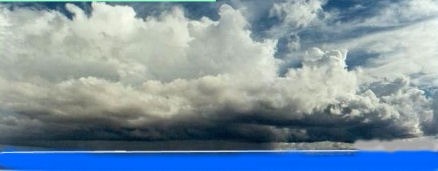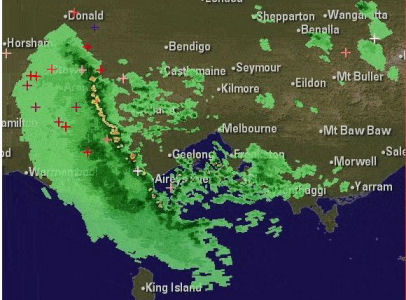During the late forties the Royal Brighton Yacht Club Regatta was the highlight of the Melbourne small boat sailing season. Held on the Australia day long weekend, it attracted a big fleet of boats and was at the top of our list of must-attend regattas held on Port Phillip Bay.
Unfortunately at that time of the year the weather in Melbourne was also unreliable, and for two consecutive years it followed the same pattern. I remember both occasions vividly.
The St Kilda fourteen foot sailing club was just a thirty minute sail around Point Ormond to the Brighton pier and in this instance a hard and hot northerly was already blowing by mid morning. As the afternoon race starting time approached, the wind had started to die and some hundred-plus boats were milling around waiting for their respective starts.
Conditions were quite pleasant for the first two laps of the “Olympic” course, but half way through the last beat the wind died away, and the Star class boats were starting to sail through the fleets of smaller boats. We could hear the slap, slap as they sailed past. We had sailed up, and into the fleet of Elwood Seahorses, and caught the heavy weight Sharpies in the light conditions, so there were a big bunch of boats closing on the weather mark for the rounding before the last run to the finish line.
A member of our crew happened to comment on the line of nasty looking clouds that had appeared on the south western horizon, and then within minutes, a tell tale thin silver strip appeared between the clouds and the sea. This storm was coming up very fast. We had seen these fronts coming through before, and they usually meant big trouble!

First the black cloud, then that silver line of broken water, then the roar, and all hell breaks loose.
In a fit of bravado we wrongly decided to carry on and round the mark, now less than fifty yards away, but before we reached it, we heard the roar and just seconds later the first big gust hit us.
Now I must explain that these fourteen foot dinghies were really grossly over canvassed, with 220 square feet of sail on a twenty six foot timber mast. Some had side decks and some, as was on our boat, only had lee cloths that had to be raised every time we went about. Nor did we carry any safety equipment; no buoyancy, not even one life jacket! But we did have one thing in our favour. Everything was made of timber and the boat capsized would float; a fact that we had proven in past capsizes.
One other big problem was that we couldn’t lower our head sail, because in an effort to reduce compression on the mast and to reduce the sag of the jib luff, the head of the jib was shackled direct to the mast, and so could not be lowered. Not very seaman like I admit, but it served a purpose.
All hell broke loose, we were caught beam on, and didn’t stand a chance. The boat floated on its side about eighty percent submerged, but the wind force was such that the pressure on that twenty percent above the water just drove the mast under, and there we were with the boat completely upside down, but still floating with the bottom just clear of the water.
We were not particularly worried we had been in the drink plenty of times before, and even in Melbourne the water temperature at that time of the year wasn’t too bad, although we had never been upside down before.
All around us there was chaos. The mast of a Star exploded as it took off around the mark. A Payne Mortlock sailing canoe, its crew out on the planks, disappeared in a cloud of spray. A Tumlaren (keel boat) went past with its mast almost parallel to the water and dozens of boats lay capsized in the water. The crew of a Seahorse near us managed to right their boat, only to capsize a few seconds later. Spray was flying everywhere and a nasty chop came with the rain. These fronts moved so fast that there was never any warning until too late; radar did not exist for weather forecasting then.
After about twenty minutes in the water a rescue boat picked us, and the crews of the boats around us, up but would not take the boat in tow as there were I believe some sixty or more boats in trouble. The boat would have to look after itself for now.
More rescue boats appeared and all of the crews taken to shore, but it was not until dusk that our boat was dragged ashore. The mast was broken, the spinnaker pole lost and everything was in a terrible tangle, but fortunately the spinnaker bag was tied in, so no sails were lost. So there was only a new mast to build before the next weekend, but some late nights would fix that, and I planned never to end up in that situation again.
Next year and another Australia day at Brighton, that hot northerly in the morning, the wind easing by start time, and by four o’clock in the afternoon those black clouds appeared on the horizon, and then it happened again just like the year before but this time we were ready for it. Down came the sails (including the jib) and we headed the boat for shore. We survived the first blast, but the second capsized us.

These cold fronts swing up from the South Pole and the temperature can drop ten degrees in minutes
We had tied a life jacket to the mast step; it had lain there all season, but now it had its use. It was there to be tied to the mast top if this situation ever occurred again, no more turning upside down!!!
On this day the wind strength was claimed to reach sixty knots. I doubt that, but there were many casualties, and one fourteen footer could not be found after the storm was over. It turned up on the beach at Chelsea several days later, forty miles further down the bay and, except for some lost gear, it was undamaged.
Here in Queensland we are fortunate with our weather. Sure we have the odd cyclone and summer storms, although the water is always warm, but in Melbourne the weather is unpredictable ,and in the early part of the sailing season very cold, and those fronts still come roaring thru, and sometimes a succession of them last for days.